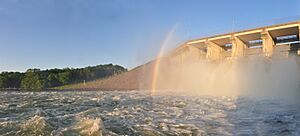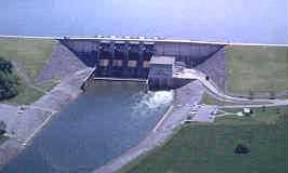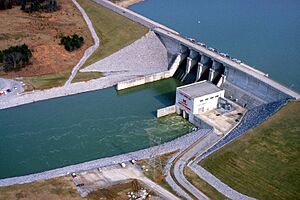J. Percy Priest Dam facts for kids
The J. Percy Priest Dam is a large dam located in north central Tennessee. It sits on the Stones River, which is a smaller river that flows into the Cumberland River. You can find it about 10 miles (16 km) east of downtown Nashville.
Behind the dam is a big lake called Percy Priest Lake. This dam is one of four main dams that help control floods in the Cumberland River area. The other important dams are Wolf Creek Dam, Dale Hollow Dam, and Center Hill Dam.
Contents
Building the Dam
The idea for this dam started with a law called the Flood Control Act of 1946. Back then, it was going to be called the Stewarts Ferry Reservoir.
Later, in 1958, its name was changed to honor J. Percy Priest. He was a Congressman from Tennessee. Building the dam began on June 2, 1963. It was finished in 1968. The U.S. Army Corps of Engineers oversaw the entire construction. They are experts at building and managing waterways.
Dam Strength and Purpose
J. Percy Priest Dam stands about 130 feet (40 meters) tall above the riverbed. It is a very long dam, stretching about 2,716 feet (828 meters). The dam is made from a mix of earth and concrete.
It also has a special power plant that uses the water's force to make electricity. This hydroelectric power plant creates 28 megawatts of power. This electricity goes into the grid managed by the Tennessee Valley Authority (TVA). The TVA works with the Army Corps of Engineers to manage all the dams in the Cumberland River Valley.
The dam is very important for preventing floods. It has greatly reduced how often and how badly floods happen in the Cumberland Valley. Besides flood control, it also provides a lot of electricity for the area. You can easily see the dam from Interstate 40 as it crosses the Stones River.
A Story of Strength
In 1979, some people tried to damage the dam using dynamite. They hoped to cause a big flood. However, they only managed to cause about $10,000 worth of damage to some metal doors at the bottom of the dam. They did not succeed in harming the main structure. This event showed just how strong and well-built the dam is.
Water Levels at the Dam
The water levels behind and below the dam are carefully watched. These levels are measured in feet above mean sea level.
Lake Levels (Behind the Dam)
- 504.50 feet: This is the highest level the dam can hold floodwaters.
- 494.50 feet: At this level, some parts of Elm Hill Marina might start to get wet.
- 490.00 feet: This is the usual water level during the summer months (April to October). It's called the Summer Pool.
- 483.00 feet: This is the usual water level during the winter months (November to March). It's called the Winter Pool.
- 480.00 feet: This is the lowest permanent water level in the lake.
River Levels (Below the Dam)
You can find current water levels and how much water is being released from the dam online. The Tennessee Valley Authority (TVA) shares this information with everyone.
If the J. Percy Priest Dam is releasing about 9,000 cubic feet per second (255 cubic meters per second) of water, it takes about 28 hours for the lake level to drop by 1 foot (0.3 meters).
- www.tva.gov/lakes/jph_o.htm
![]() This article incorporates public domain material from websites or documents of the United States Army Corps of Engineers.
This article incorporates public domain material from websites or documents of the United States Army Corps of Engineers.





